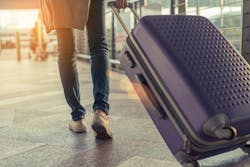Pack Your Bags: Air Travel Is About to Get Easier and Safer
Flying is more popular than ever. Last year alone, worldwide passenger traffic jumped to 8.3 billion – a 7.5 percent increase from the year before – and aircraft movement rose 3 percent in the same period. With travel becoming more common around the world, airports are facing the difficult challenge of accommodating more travelers than ever before while avoiding investing in larger spaces or purchasing additional aircrafts. Physical infrastructure expansion is often not an option due to lack of land; not to mention large-scale construction projects take up valuable time, during which travel needs continue to evolve and expand.
The answer to moving a higher volume of passengers at faster speeds is to simplify the traveler experience. From walking into an airport, to arriving at a destination, technology will make the future of travel an easy and simplified process, allowing passenger traffic to flow and profits to roll in. While every airport recognizes this need to streamline, some fear easy airport experiences will come at the price of decreased safety. But security and simplicity do not have to be mutually exclusive for long. We are rapidly moving toward a future in which emerging technologies are solving the tug-of-war between the desire for simple, intuitive experiences, and increased security. These technologies are currently being rolled out around the world and will soon be a fundamental part of every airport, altering the way we experience air travel.
Here are the three areas of air travel that will be most affected by technology that ensures simultaneous passenger ease and safety:
Disrupting Security Lines with Biometric Scanners
Security lines are the number one way airports keep people safe – and slow them down. Airport security check points, while the most time-consuming and unsavory part of flying, serve a valuable purpose in ensuring all travelers remain safe from harm. These checkpoints cannot be removed entirely, but they must be reimagined if airports are going to continue increasing customer volume. TSA PreCheck has made a significant impact on efficiency in recent years, but the inconvenient process to achieve this status deters many passengers from taking advantage of the system. The solution in redesigning security check points is replacing the current system with biometric scanning technology.
Biometric technology offers facial, fingerprint, palm, voice, iris, and retina recognition capabilities that identify passengers with hyper accuracy. Combined with a database of biographic information on travelers that will flag any suspicious activity, these solutions allow people to step through security lines in literally a blink of an eye. Companies like CLEAR are already putting this technology to the test at over 30 airports worldwide, simultaneously improving safety measures and increasing checkpoint speed. The reliability of biometric scanning makes scanning IDs and boarding passes obsolete, opening up the possibility of airports eliminating the requirement for passengers to carry them completely.
Prioritizing Flight Landings with Voice Technology
Scheduling flight landings and take-offs is complicated business, involving many oscillating factors from the wind speeds to fuel levels. Luckily, automation technology is simplifying the process by proactively evaluating and ordering each flight. By deciphering all the data points involved with each flight, automation technology determines which flight can leave and arrive on which runway and at which time, cutting down on bottlenecks and unnecessary taxing on the ground. Besides speeding up the process and decreasing delays, this technology greatly enhances the safety of passengers just by analyzing the pilot’s voice.
Due to weather, scheduling, or personal reasons, pilots can experience high levels of stress in the air.
According to a recent account, pilots can even go without eating between back to back flights or work over 13-hour days. Using natural language processing (NLP) technology, solutions are actively being discovered that prioritize flights based on the tone and perceived anxiety level of a pilot’s voice, giving landing preference to a plane that may be at higher risk.
Navigating Baggage Claim with IoT Tracking
Anyone who has checked a piece of luggage knows the feeling of anxiously staring at the conveyor belt, waiting for the right suitcase to appear. But worrying about baggage safety will soon be a thing of the past. By retrofitting checked luggage with Internet of Things (IoT) enabled tags, passengers will be able to see exactly where their bags are moving from an app on their phones, tracking them from the moment they are out of sight, to picking them up at baggage claim. Imagine the peace of mind for passengers in being able to pin point their luggage, and decrease the time spent crowding around the conveyor belt.
IoT technology also has the power to help airport officials keep track of cargo, streamlining the ground handling system with greater visibility into the moving bags. Last year alone, cargo traffic rose 7.7 percent worldwide – making IoT solutions more needed than ever as airports manage a high volume of moving pieces on the ground. The sensors will also be able to detect temperature and humidity of these bags in transit, quickly identifying any luggage that could pose a threat.
These are just a few of the ways emerging technologies are greatly impacting both the safety and ease of air travel, making it possible for airports to continue to meet the demands of the growing number of passengers. Not only will IoT, NLP, and biometric solutions accommodate the already increasing passenger traffic, they will make flying so simple that it will attract new customers. In the future, it may even be considered easier to fly than take a train or car for mid-range distances. The future of technology-enabled, passenger-centric security and simplicity is on the horizon – and it will transform the way we think about flying for the better.
